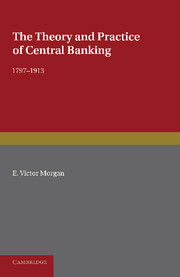Book contents
- Frontmatter
- Contents
- Tables
- Editorial Preface
- Author's Preface
- Chapter I Banks and Banking in the Early Nineteenth Century
- Chapter II The Bank Restriction Period, 1797–1821
- Chapter III Monetary Theory of the Bank Restriction Period
- Chapter IV The First Years of Resumption, the Crisis of 1825, and the Bank Charter Act, 1833
- Chapter V The Horsley Palmer Experiment, and the Bank Charter Act, 1844
- Chapter VI The Currency and Banking Controversy
- Chapter VII The Trial of the Bank Charter Act, 1844-58
- Chapter VIII The Great Boom, 1858-73
- Chapter IX The Great Depression, 1873-96
- Chapter X The Last Years of the Gold Standard, 1897–1913
- Chapter XI Monetary Theory of the Second Half of the Nineteenth Century
- Appendix Changes in Bank rate, 1876-1913, with the Amount of the Reserve of the Banking Department and the “Proportion” on the preceding Wednesday
- Index
Chapter I - Banks and Banking in the Early Nineteenth Century
Published online by Cambridge University Press: 05 June 2016
- Frontmatter
- Contents
- Tables
- Editorial Preface
- Author's Preface
- Chapter I Banks and Banking in the Early Nineteenth Century
- Chapter II The Bank Restriction Period, 1797–1821
- Chapter III Monetary Theory of the Bank Restriction Period
- Chapter IV The First Years of Resumption, the Crisis of 1825, and the Bank Charter Act, 1833
- Chapter V The Horsley Palmer Experiment, and the Bank Charter Act, 1844
- Chapter VI The Currency and Banking Controversy
- Chapter VII The Trial of the Bank Charter Act, 1844-58
- Chapter VIII The Great Boom, 1858-73
- Chapter IX The Great Depression, 1873-96
- Chapter X The Last Years of the Gold Standard, 1897–1913
- Chapter XI Monetary Theory of the Second Half of the Nineteenth Century
- Appendix Changes in Bank rate, 1876-1913, with the Amount of the Reserve of the Banking Department and the “Proportion” on the preceding Wednesday
- Index
Summary
THE BANK OF ENGLAND
When John Horsley Palmer, Governor of the Bank in 1832, was asked what were its chief functions, he replied:
To furnish the paper money with which the public act around them, and to be a place of safe deposit for die public money, and for die money of individuals who prefer a public body like die Bank to private bankers.
It will be noticed that Palmer stresses the action of the public with the notes provided by the Bank, for throughout the first half of the century the Bank was earnestly disclaiming any active role in determining the quantity of money.
But already the Bank's functions had ramifications which are hardly suggested in Palmer's simple outline. The functions of a modern central bank are fourfold: to act as manager of the National Debt and banker to the government; to regulate the currency; to be a banker's bank, and to act as lender of last resort. Even at the beginning of the nineteenth century we can find important traces of all these functions.
The Bank and the National Debt had grown up together, and critics of both said that the prosperity of the Bank depended on the Debt. The Bank kept the books in which transfers of stock were recorded, and made the dividend payments, for which services it received a commission prescribed by the terms of the charter. The Bank also handled the government account. The revenue was received and accumulated as government deposits, on which, in accordance with the Bank's usual rule, no interest was paid. When payments exceeded revenue, the government was allowed to overdraw its account by means of deficiency bills and special advances. After their formation in 1826 the branch banks assisted in the collection of the revenue, by receiving it from the commissioners in the provinces, and crediting it to the government account in London. The very complex machinery of the Exchequer was somewhat simplified by an act of 1834, by which payments formerly made to the Tellers of the Exchequer were now made direct to the Bank.
The amount which the Bank could lend to the government was fixed by law, but during the French wars Pitt had the restriction removed, after the directors had questioned the legality of the advances which he required.
- Type
- Chapter
- Information
- Publisher: Cambridge University PressPrint publication year: 2013



